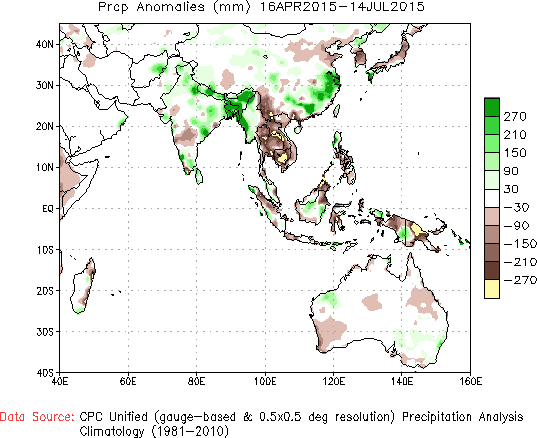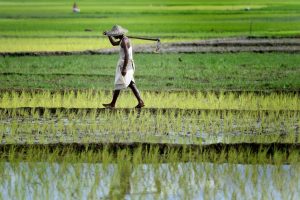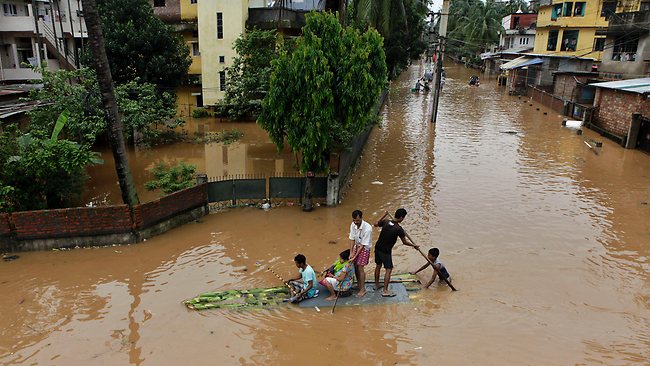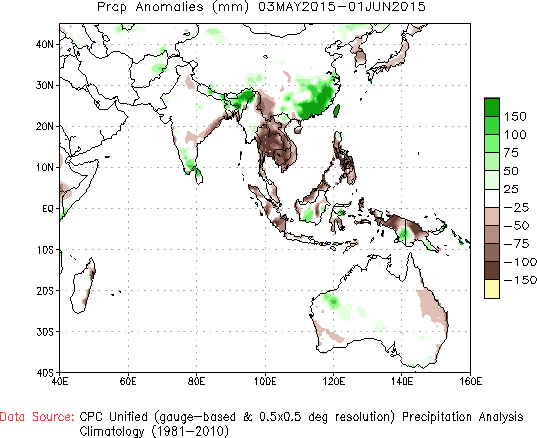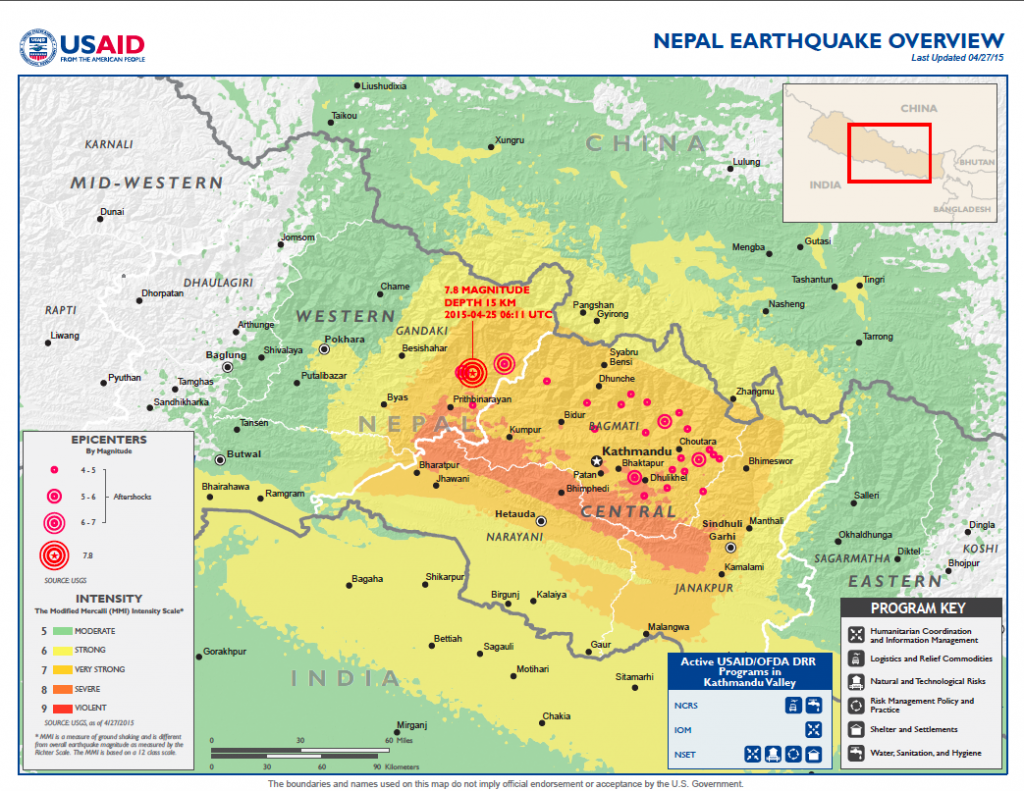Home » Posts tagged 'monsoon'
Tag Archives: monsoon
Thailand drought leaves lasting effects, even as rainy season begins
By Harland Dahl
While some areas of Thailand currently face heavy monsoon rains, others suffer from the effects of a drought that began in November of 2014. This was the worst drought experienced by Thailand in over a decade.
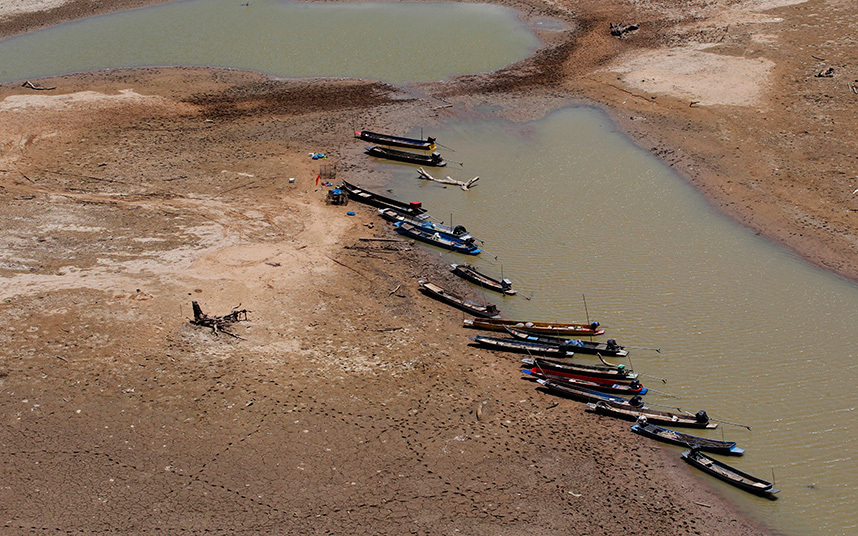
The drought has had lasting negative effects on Thailand’s agricultural sector and has led to difficulties in rice farming, a crucial crop for Thai farmers and families. Thailand is the world’s largest rice exporter, with rice farming taking up 40% of Thai agricultural land and representing a significant portion of Thailand’s labor force and economy.
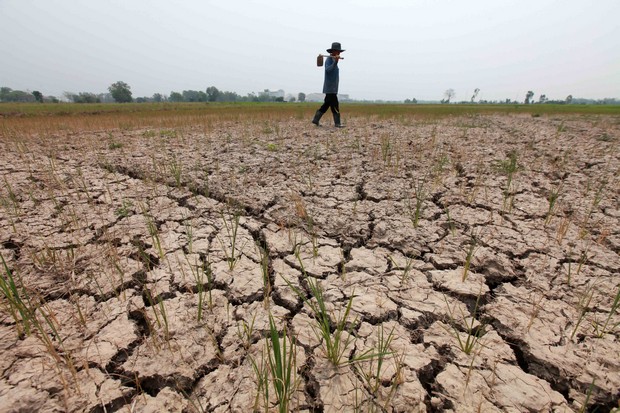
Other crops have been affected, as well, threatening the livelihood of many Thai citizens. Over half of Thailand’s working age population is supported by the agricultural sector.
In response to water shortages caused by the drought, the Thai government has asked farmers to delay rice production. Thai Minister of Agriculture and Cooperatives Petipong Pungbun Na Ayudhya explained, “The agriculture ministry and irrigation department have requested that farmers delay rice planting in the Chao Phraya area because the Chao Phraya area is a large rice growing area… and we need to organize the water that is being used.”
By delaying rice production, the government hopes to reduce nonessential water usage until monsoon rains bring relief from the drought. Thailand’s rainy season usually lasts from May to October, bringing an average of 2.4 meters of rain to Thailand’s southern regions, and 1.4 meters to the northern and central parts of the country.
Although Thailand’s rainy season had already begun, as of July 6th, 22 of the country’s 76 provinces were still facing drought conditions. The Thai Meteorological Department anticipates that this year’s rainy season will deliver mostly “near normal” rains. A report published by the department on June 26th predicts that the southwest monsoon will begin to travel north in July, bringing heavy to very heavy rains to Upper Thailand. Then, as is typical in the seasonal cycle, the rainfall maximum of the South Asian monsoon will shift southward in October towards Southern Thailand.
The Thai government is struggling to simultaneously provide relief from the drought, implement a water management plan to safeguard against future droughts, and prepare for threats presented by monsoon rains.
In response to the drought, the Thai government has implemented a system of daily water delivery to the most drought-affected areas using water trucks. Unfortunately, these efforts have often been insufficient to fulfill many communities’ water needs. The government has also used cloud seeding technology to create artificial rain to aid Thai farmers who depend on rice farming for their livelihood and keep rice production levels up.
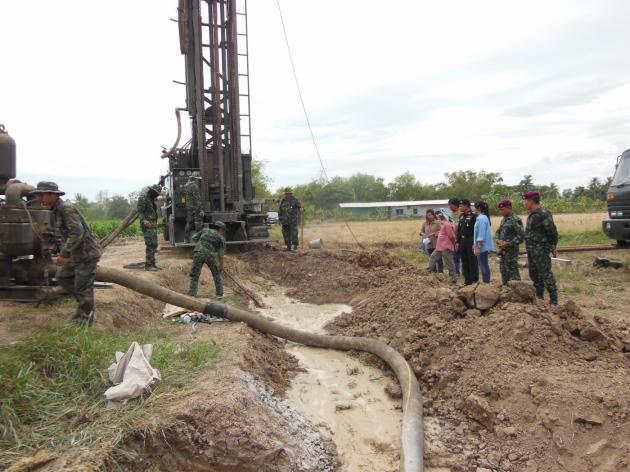
Thailand has also announced a plan to invest $7.5 billion in water management projects in the coming years. These include a 10-year water management plan, a replacement for the less successful management plan of a previous regime.
The start of the rainy season has already led to flooding and mudslides in Bangkok, as well as in Thailand’s Central Plans. To prepare for future rains, the government has begun to dig waterways to contain rainwater and use social media to warn citizens of flooding risks.
Monsoon affects economy, health in India
By Harland Dahl
India’s monsoon hit the Southern Indian state of Kerala on Friday, June 5th, four days later than expected. With monsoon rains comes relief from India’s stifling heat wave, which began in May.
The Indian Institute of Tropical Meteorology predicts that the monsoon will spread across most of India by the end of June. Rains are expected to reach the country’s West coast by June 17th and central India by June 25th. The India Meteorological Department predicts that the monsoon will be weaker than usual, bringing less than 90% of typical monsoon rainfall.
It is estimated that crop planting in India has gone down by 9% since last year. This is due to weak monsoon rains, which not only lead to low crop production, but to high food prices. The crops most affected are grains and cotton.
In response, the Indian government has taken several steps to boost agricultural production. The India Meteorological Department has begun to send mobile weather alerts to farmers, and public officials have been promoting the cultivation of more drought-resistant crops.
Minister of Agriculture Eknath Khadse explained, “Growing vegetables and fruits would be our priority. This will give farmers something for daily survival, without too much investment, along with the main crops ahead of the kharif season.”
The agricultural sector employs more Indian citizens than any other sector of the economy. This means that a below-average monsoon could have a significant effect on the Indian economy, as a whole. The ICICI Bank of India estimates that weak rains will cause a drop in India’s GDP growth for this fiscal year, from the originally estimated growth rate of 7.8% to 7.3%.
But even during a relatively dry year, monsoon rains have the potential to negatively impact other sectors of the Indian economy, as well. Heavy rains put crucial infrastructure at risk throughout India, and are particularly threatening to burgeoning industrial cities such as Bangalore, home to 30% of India’s startup companies.
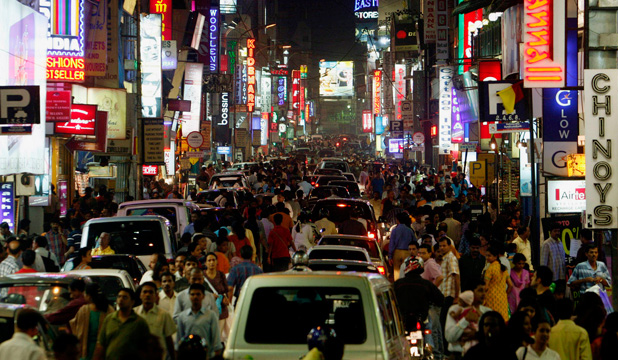
With heavy rains come blackouts and losses in internet connectivity. While larger corporations can afford more reliable internet connections, smaller companies often depend on unreliable nationwide internet service providers or local cable networks.
Weakened infrastructure has also lead to sanitation problems in many parts of India, particularly in poorer parts of the country’s largest cities. Although overall water contamination levels have gone down in the past decade, contamination usually rises significantly during monsoon season.
Rising underground water levels during the monsoon season affect outdated underground sewages systems and leaking pipes, leading to abnormally high levels of E Coli and other bacteria. These bacteria cause diarrheal disease and various water-borne illnesses.
Vector-borne diseases such as malaria and dengue are also particularly prominent during monsoon season. To avoid exposure to contaminants, Indians are encouraged by health officials to take precautionary measures such as boiling all drinking water and only eating foods stored inside.
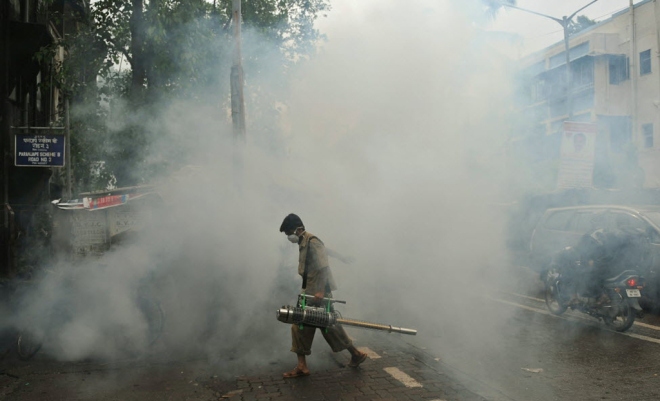
Fumigation efforts are also ramped up during monsoon season, which is also breeding season for mosquitos. Those most affected by both vector and water-borne diseases include children and the elderly, often due to time spent outside or an inability to fend off infection.
India awaits monsoon after deadly heat wave
By Harland Dahl
India faces a heat wave annually, but this year temperatures have been higher than normal. As of June 2, the heat wave’s death toll reached over 2,300. This makes the 2015 Indian heat wave the fifth deadliest heat wave in world history, and the second deadliest heat wave in Indian history.
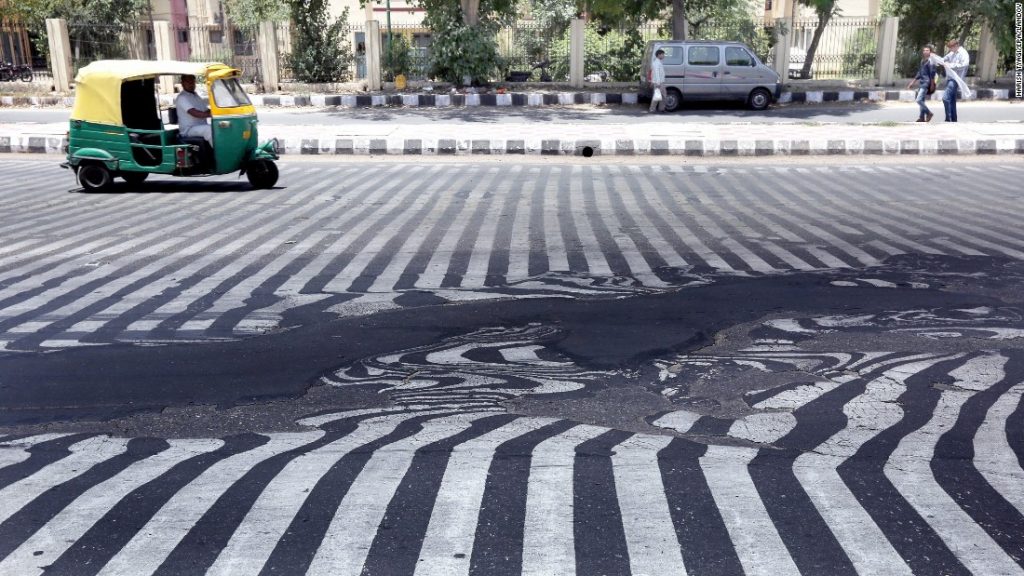
The states most affected by the heat wave were Andhra Pradesh and Telangana in southeast India, with 1,490 and 489 deaths, respectively. Other deaths occurred in the states of Uttar Pradesh, Punjab, Odisha, and Bihar.
The poor, who must continue to work to support themselves despite soaring temperatures, have suffered the most casualties. These include construction workers, many working as day laborers in the nation’s capital. Elderly Indians have also been disproportionately affected by the heat wave. These casualties are often the result of heat stroke or dehydration.
The heat wave lasted for weeks, bringing temperatures up to about 120 degrees Fahrenheit. The abnormally high temperatures are likely related to the infrequent pre-monsoon season rains. These rains brought less water to India than they have in the past, leaving Indian cities hot and dry.
The approaching monsoon season has already begun to bring relief for Indian citizens suffering from these high temperatures. Unfortunately, the monsoon, which was expected to arrive between May 29th and 31st, has been delayed. Light to moderate rainfall occurring before the onset of the continental-scale monsoon has cooled some regions, and most regions have cooled somewhat in the past few days.
Meteorologists have delivered conflicting predictions as to when the monsoon will arrive, but many agree that it will be around June 4th or 5th. When the monsoon arrives, its rainfall generally expands northward across India.
This means continued danger for already at-risk Indian citizens. In order to combat this threat, the Indian government has taken several precautionary measures. These include the distribution of oral rehydration kits and administration of intravenous fluids in public places such as bus stops and train stations.
Indians, many of whom have been suffering from headache and dizziness, have tried various methods to stay cool. In some cities, the demand for air conditioning in response to the heat wave has led to power outages. In other areas, Indians have been spending the warmest part of the day in rivers or streams to cool off. The government has also advised citizens to remain indoors or in the shade as much as possible.
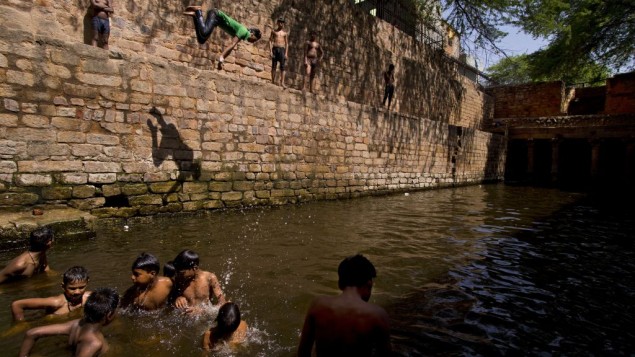
When the monsoon does arrive, it is possible that it will bring less rainfall than usual. The summer monsoon, which typically lasts from June to September, is predicted by the India Meteorological Department to bring levels of rain that are “below normal” — only 90% of normal according to their just-issued seasonal forecast. Last year this was also true, with the 2014 monsoon resulting in a 12% rainfall deficit. This year the monsoon could be inhibited by the current El Niño event that is predicted to strengthen during summer.
Hotter temperatures are generally expected to result from climate change. India’s National Disaster Management Authority states that climate change has caused more frequent and severe Indian heat waves in recent years.
The Intergovernmental Panel on Climate Change agrees, reporting that “higher daily peak temperatures and longer, more intense heat waves are becoming increasingly frequent in South Asia as a result of climate change.”
Limited rains like these could mean a lasting drought and limited agricultural production for India. As the monsoon brings four-fifths of India’s annual rainfall, it is crucial for millions of Indian farmers.
Two earthquakes bring health risks to Nepal
By Harland Dahl
A 7.3 magnitude earthquake hit Nepal last Tuesday, only two weeks after a devastating 7.8 earthquake shook the country on April 25th. These earthquakes killed over 8,000 people and displaced close to 3 million others.
Today, Nepal’s government and organizations are struggling to rebuild critical infrastructure and provide those affected with food and shelter.
Many factors have made relief efforts challenging, including Nepal’s mountainous terrain, the high proportion of Nepalese people living in rural areas, and limited funding. These efforts are further complicated by the impending monsoon season.
Nepal’s monsoon season is expected to begin in June, giving aid workers between three and five weeks to prepare for heavy rains. The monsoon season usually lasts from June to September, bringing Nepal 80 percent of its precipitation for the year. Nepal’s average annual rainfall is 1.6 meters (about 5 feet), with some regional variation across Nepal.
With monsoon season comes many risks for Nepalese people. Heavy rains lead to water-borne diseases, sanitation problems, the contamination of drinking sources, and worsened living conditions. The impending monsoon will also present challenges for the Nepalese government and international organizations attempting to deliver aid. To combat these threats, the government and aid organizations are focused on improving infrastructure and sanitation before the monsoon hits.
The earthquakes destroyed or damaged much of Nepal’s sanitation and water infrastructure, including water pipes and latrines. In response, the Nepalese government has announced a plan to construct temporary pit latrines in the weeks before the monsoon hits. They hope to build one latrine for every 50 Nepalese males and every 30 Nepalese females.
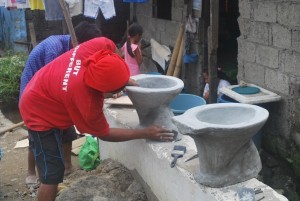
Aid organizations such as the UN and OCHA have focused on providing temporary shelter for families whose homes were rendered uninhabitable by the two earthquakes. It is imperative that these temporary shelters be provided prior to the start of the monsoon season in order to give earthquake victims protection from health risks brought by heavy rains.
While some displaced people use “Shelter Kits” provided by agencies such as the UK’s Department for International Development, others use vegetation and materials found in rubble to build shelter for their families. Buildings that survived the earthquakes are also being used as emergency shelters, including schools and some governmental buildings.
The monsoon will also cause logistical problems for the Nepalese government and aid organizations. Rainstorms will make travel and the transport of food and supplies to remote communities especially difficult. Relief operations will not only encounter flooding and mountainous terrain when attempting to deliver aid, but an increased risk of landslides, a result of earthquakes worsened by the start of monsoon season. Helicopters, which are often used to deliver aid to hard-to-reach regions, will be grounded by the heavy rains, as well.
Relief workers are attempting to combat these logistical barriers by changing the methods they use to reach affected populations. In lieu of vehicles, some aid workers have begun to carry supplies to rural communities by foot. Other workers have been using mules, donkeys, and paid porters to deliver supplies to remote locations. The Nepalese government has also taken advantage of social media as a way of warning citizens of impending rainstorms and informing citizens of where and how to acquire supplies and relief.
With funding low, many relief organizations are having difficulties implementing relief operations before the start of the monsoon season. The United Nations, for example, has announced that it has only raised 20 percent of the estimated $432 million necessary to carry out its planned relief operations.
